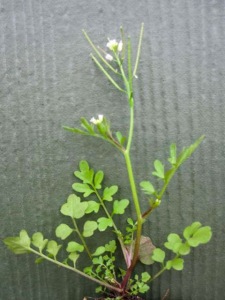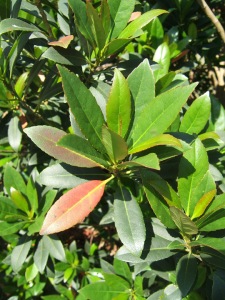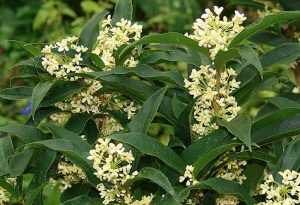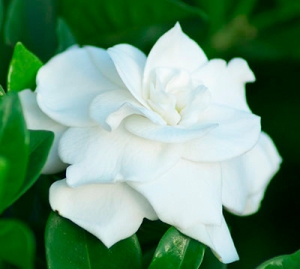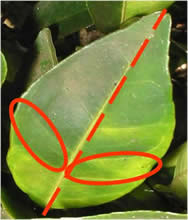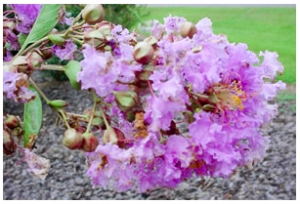A: The weed is hairy bittercress, Cardamine hirsute, and it typically is a winter annual but it will continue to grow in shaded, moist areas if it is not pulled or controlled. It produces large numbers of seeds which have a high germination rate. This, of course, means almost all the seeds become adult plants. It would be nice to have this kind of production rate on our vegetables and flowers! The basal leaves somewhat resemble parsley and it has a small cluster of white flowers at the top. Hairy bittercress often comes with contain plants so consider removing any weed from pots before you bring them home. I always return them back to the nursery and tell them I will not pay for plants I do not want! No one every laughs but better to dispose of them at the nursery then let them become a problem in your landscape. There is another weed, very similar looking to the Hairy bittercress but its leaves are much smaller and it prefers dry soils. Neither weed is a bonus in the landscape.
Monthly Archives: February 2015
Q: What can you tell me about the Japanese blueberry shrub and can I grow it here?
A: Japanese blueberry, Elaeocarpus decipens, can be grown in our cold hardiness zone. This evergreen tree grows about 30 to 40 feet tall and equally as wide. Japanese blueberry prefers well drained soil and full sun. Some interior foliage turns bright red and drops in spring and periodically throughout the year. This is normal and is not cause for concern. Japanese blueberry has small, inconspicuous fragrant flowers. It has a propensity to become chlorotic on high pH soils so this might limit using it in commercial or home sites where soil is often alkaline. It is too difficult to lower the pH for any substantial amount of time to keep the plant lush and green in an alkaline environment. The high production of fruit may cause it to be messy on walkways. However, berry production should not be a problem if using it as a hedge in a home landscape. Just keep its shrub away from driveways and sidewalks. Piercing sucking insects may be a problem, but early scouting of insect feeding can be controlled with either insecticidal soap or ultrafine horticulture oil. Formation of sooty mold is your best indication the pest populations have become too high.
Q: Would Tea Olive be a good hedge choice here?
A: Tea Olive, Osmanthus fragrans, is a small evergreen tree or shrub which can grow up to 25 feet tall but typically is about 15 feet tall with10 feet spread. The lustrous, medium‐green leaves have paler undersides and are joined from October through March by a multitude of small, but extremely fragrant, white blossoms. They perfume a large area of the landscape and can be showy in some years. I believe they would make an excellent hedge as long as you kept them tall. It tolerates full sun to part shade but does poorly in wet sites and where soil does not drain well. It is not salt tolerant and although can fit into a landscape well with typical lawn irrigation, the one at my office receives no additional water outside rainfall and does beautifully. No pests or diseases are of major concern. Scales and nematodes may present a problem, and mushroom root rot is troublesome when the soil is kept too wet. With its upright oval to columnar growth habit in youth, Sweet Osmanthus is ideal for use as an unclipped hedge or trained as a small tree, and should be placed where its fragrance can be enjoyed. Since the flowers are not particularly showy, people will wonder from where the delightful fragrance originates. This is a subtle plant which should be used more often in Southern landscapes. Plants thin somewhat in the partial shade, but form a dense crown in a sunny location. Planted on 4 to 6 foot centers, Sweet Osmanthus can form a wall of fragrance during the fall, winter and spring and should be planted more often. They will not grow as fast as Leyland Cypress, but think of this Osmanthus as a substitute for use in a sunny spot. Plants can be clipped to form a denser canopy, but flowers form on old stems.
Q: Should I prune my gardenias or azaleas now?
A: This is one of the most common questions I get every February. So I am repeating my answer from a previous Garden Talk. Gardenias, like azaleas, would need to be pruned after they have finished flowering, which will be sometime late spring or early summer. The best management practice for most any flowering plant is to prune directly after flowering. If they are pruned now in late winter, then we will reduce the number of flowers produce as the buds for flowering have already been formed. Gardenias and azaleas really require very little pruning except to improve their shape and/or remove broken or diseased stems. It is possible to prune azaleas or gardenias to increase flower production but keep the removal of stems to a minimum. Selectively prune a stem by hand rather than use a motorized pruning utensil. Hand prune the stems selectively by cutting back to a bud and be sure the stems are cut at a proper angle. Cuts should be made about ¼ inch above the bud. It is also best to prune the shrubs so they are smaller on the top and larger on the bottom to allow for the best exposure to sunlight. Remember, gardenias like well-drained, acid, organic soils. It is important not to water them as often as we do lawns. Avoid using heavy rock mulch around the root area as this will cause compacted soil. Consider using pine straw or pine bark as a mulch. Leave an area about 12-18 inches around the trunk with nothing but soil and air, which is an excellent practice for any tree or shrub. I know everyone is eager to get out and prune their perennials but it is best to wait a little longer until we are certain the fear of freezing temperatures is truly over.
Q: My citrus tree is dying and I think I have citrus greening.
A: I have had this question 4-5 times within the last few weeks. First, we do several confirmed cases of Huanglongbing (HLB) here in Nassau County Florida. The correct name for “citrus greening” is Huanglongbing (HLB). Secondly, there is no cure or chemical spray to prevent the disease at this point. In addition, some of the nutrient deficiencies and root decays can mimic several of the symptoms of the disease. Just because your fruit is not totally orange or yellow, does not necessarily mean you have HLB. We should be diligent about controlling the insect which we believe transmits the bacterium. I have found it on the citrus at my Yulee office even in January although it is most active in the spring and summer. I would suggest using insecticidal soap or horticulture oil for controlling the insect and the chemical must come in direct contact with the insect to kill it. Neither one of the chemicals listed above have any real residual effect so it is a waste of time, money and chemical to spray the tree if the insect is not present. This means you must see the insect and use the chemical directly on the insect for it to work properly. Do not use heavy broad spectrum insecticides when the other two work beautifully. Severe cold temperatures in the winter and harsh, hot temperatures in the summer can weaken the bacterium internally once it is inside the tree. We are hoping this may slow the spread of the disease and provide a few more years of productivity but there are no guarantees. More importantly, how can we predict or be sure either of these environmental conditions will occur? The best diagnosis for HLB is the asymmetrical, blotchy yellowing of leaves. Think about folding the leaf in half, right down the middle (lengthwise). If both sides of the leave look somewhat the same, then your tree does not have HLB. Look over the University of Florida document which will provide the best and most accurate information on identification. This disease has devastated most of the citrus industry throughout the world. We will just have to ride this out and hope for the best as backyard growers – it is definitely a deadly disease on citrus. The fruit will also be medicinal tasting or taste gasoline-like. This will not improve over time and therefore you should consider cutting the tree down. Of course, the decision is totally up to you. http://www.crec.ifas.ufl.edu/extension/greening/index.shtml
Q: I would like some dwarf, evergreen shrubs to plant in the front of my house. I do not have much space but I also do not want to be spending a great deal of time pruning them to keep them short. Do you have any ideas?
A: The following list of shrubs will grow to about 4 feet tall with a spread of about 3-6 feet. Try any of the following evergreen shrubs for smaller areas such as Rose Creek, Francis Mason, Prostrata, Sherwoodii which are dwarf varieties of Abelia for full sun areas. These shrubs are evergreen as long as temperatures stay above 10 degrees Fahrenheit. Pittosporum cultivar called Crème de Mint is a variegated form reaching heights of only 3 feet with about the same width. Poet’s Laurel, Danae racemosa, produces pretty orange berries in the fall for those shade to partial shady sites. Prostrata; Radicans Variegata are some examples of dwarf gardenia which will provide fabulous, fragrant flowers if you have partial sun to partial shade and acid soil. Indian Hawthorn cultivars Olivia, Eleanor Taber, Indian Princess, and Gulf Green will grow in full sun to partial sun areas. These particular Indian Hawthorn shrubs are resistant to the pesky leaf spot which plague so many other shrubs in this family. Although they are not evergreen, there are several dwarf varieties of crape myrtle which we often overlook. Consider one of the following: Chickasaw (3 ft tall), Firecracker (3-5 ft), Ozark Spring (3-5 ft), Pocomoke (3 ft.), or Victor (4 ft). Then, of course, consider some of the smaller bush or drift roses. We have plenty of choices so there is no reason to plant one of the standard tree varieties of viburnum, ligustrum, holly or pittosporum as they would prefer being 12 – 20 feet tall. Trying to keep them at 3-4 feet is brutal.

